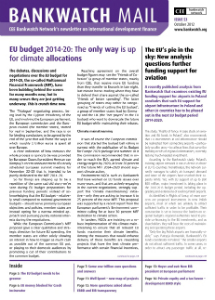Money, and the EU’s climate agenda, to burn: EBRD mining strategy on a carbon collision course

Bankwatch Mail | 9 October 2012
With the EBRD due to sign off on its new mining strategy in November this year, 22 MEPs have pointed out in an open letter to European Commissioners that given the state of the policy draft the bank risks contradicting the EU Resource Efficiency Roadmap and responsible mining principles. At risk of being compromised too, Bankwatch believes, are the EU’s 2020 strategy and EU commitments on climate change and biodiversity protection.

This article is from Issue 53 of our quarterly newsletter Bankwatch Mail
Browse all articles on the right
(This article is not available in the pdf version of Bankwatch Mail 53.)
According to German MEP Reinhard Bütikofer, the initiator of the open letter, “The EBRD is right in drafting a new mining strategy as the raw materials policy is climbing to the top of political agendas. But this strategy must be in line with EU objectives and standards. The EBRD has financed coal mining without taking responsibility for coal combustion’s contribution to climate change. This is not only short-sighted but at odds with the EU’s very own climate agenda.”
In a September response letter replete with EBRD-ese long familiar to Bankwatch, Commissioners Olli Rehn, Janes Potocnik and Connie Hedegaard downplayed the vital coal combustion issue set to be further fuelled by EBRD investments under the new mining strategy. The European Commission has an important say in EBRD decisions with an EU representative on the bank’s board of directors, alongside other directors from the EU’s member states.
EBRD mining facts and figures:
Over the last ten years the EBRD has facilitated investments of around EUR 2 billion in the mining sector across the CEE region.
Six projects out of a total of 26 mining projects financed by the EBRD since 1999 – around 25 percent – have gone to coal projects.
EBRD loans to the coal mining sector in just two countries – Mongolia and Serbia – have amounted to at least EUR 216 million out of a total of EUR 290 million invested in coal projects, comprising 42 percent of the EUR 685 million for all mining projects financed by the bank.
Alarmingly, the trend for the EBRD’s coal lending is not decreasing in percentage terms; in 2010-2011 EBRD loans to coal mining projects made up a majority of its total mining lending.
The first draft of the EBRD’s new mining strategy was published earlier this year in April. Environment NGOs, including Bankwatch, have found this draft document to be weak and highly concerning as it sets the EBRD on a course of continuing to provide financial support for coal mining, even though the exploitation of new coal resources is recognised to be one of the main contributors to climate change.
Of equal concern is the fact that the EBRD has refused to disclose its responses to NGO comments on the draft strategy. As Bankwatch’s EBRD coordinator Ionut Apostol points out, “What we want to see in the decision-making over the future mining policy of the EBRD is a genuine inclusion of civil society, particularly of potentially affected communities. The process of drafting the mining strategy has not been open enough, even though this document will have important impacts on the direction of development of countries in central and eastern Europe.”
Read more:
Information on harmful mining projects currently in the EBRD’s project pipeline are available on our website:
Most recently, the bank’s involvement in Mongolia’s mining sector stands out. Mongolia has become the promised land for mining companies – and the EBRD’s portfolio in Mongolia is dominated by investments in the natural resources/mining sectors both over the span of the bank’s operations in the country and in particular during the last two years. A coal washing plant at Ukhaa Khudag received a USD 180 million EBRD loan in 2010 and a USD 350 million loan for the Tsagaan Suvarga copper project . Currently, the EBRD is considering a loan to the Oyu Tolgoi gold and copper mine in Mongolia’s South Gobi desert.
As is being played out in Mongolia with EBRD assistance, one of the risks that persists in the new mining strategy’s current draft lies in the EBRD failing to contribute to the economic diversification of resource rich countries. Instead, aw similar situation has developed in Kyrgyzstan where the EBRD-backed Kumtor gold project is responsible for 10 percent of the country’s GDP and constitutes 40 per cent of total exports and 50 per cent of industrial production – and this is according to the EBRD’s own strategy for Kyrgyzstan. In Armenia, too, mineral exports constituted 40 percent of the total exports of the country in 2009 and the EBRD is still considering providing support for this sector in the future.
Ionut Apostol commented further: “In Mongolia and elswehere we are seeing the EBRD too often contributing to an exacerbation of certain countries’ commodity export dependence, part of the so-called ‘resource curse’. The EBRD needs to make sure that its new mining strategy avoids repeating mistakes from the past, specifically putting too much emphasis on intensive exploitation of natural resources in minerals mining as a supposed means of development. Too often, intensive resource extraction has been undertaken because of the existence of undemocratic regimes, fraud, corruption or weak environmental standards in the EBRD countries of operation. This has not benefited local populations. On the contrary, it has contributed to placing these countries on unsustainable paths, with wealth being further concentrated amongst elites.”
Theme: Social & economic impacts | Other harmful projects | Mining
Location: Mongolia
Project: ArcelorMittal Temirtau, Kazakhstan | Kolubara lignite mine, Serbia | Kumtor Gold Mine, Kyrgyzstan | Mining boom in Mongolia
Tags: BW Mail 53
Never miss an update
We expose the risks of international public finance and bring critical updates from the ground. We believe that the billions of public money should work for people and the environment.
STAY INFORMED
